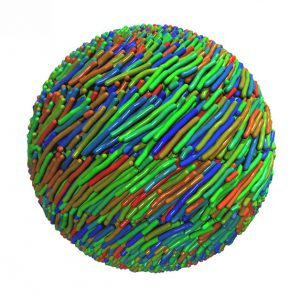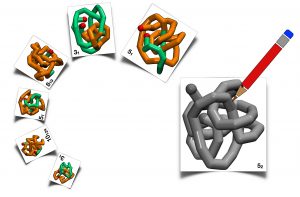Leader: Achille Giacometti, Ca’ Foscari University of Venice, Italy
Co-leader: Angelo Rosa Sissa, Trieste, Italy
General overview. To date, various strategies have been developed to control the topology of polymeric systems, be they natural or synthetic, which mostly differ for the range of involved length scales, as well as the degree of deterministic control on the target topology and geometry. One such strategy is the design of novel molecular constructs as building blocks for achieving materials with preassigned complex topologies, that can be exploited in a variety of technological applications.
Besides the case of synthetic polymer melts and gels, of particular interest are woven networks of fibres found in nature, such as microbial biofilms, three-dimensional skin cells networks and cellulose fibres. These complex arrangements exemplify how the woven character of biological materials is critical: structure and function come not only from the standard association and interaction of the elements, but also the tangling and interdigitation of the fibrous architecture and the resulting tensional forces.
General objectives of WG2. In this Action we will pursue two main strategies to advance the state of the art in controlling the topology of molecular constructs or polymer-based systems. On the one hand we will directly explore novel setups that can promote the formation of new types of knotted and linked states. On the other hand we will explore new ways, largely based on single-molecule setups, that can extend the scope of current methods for profiling the entanglement state of filamentous systems. This latter step is, clearly, a required complement of the first. These two lines can be broken down in the following goals:
-
Advance the understanding of the physical properties that determine which topologies (knots and links) can be realized in supramolecular constructs.
-
Clarify the spontaneous knotting, linking and weaving of filamentous systems (including DNA) in dilute and melt conditions, and their impact on physical properties.
-
Understand how the above-mentioned entanglement properties can be statistically controlled externally (e.g. by spatial confinement, temperature gradients etc.).
-
Suggest novel setups of single-molecule experiments, such as nanochannels and nanopores, that can extend the scope of current gel electrophoretic methods for topological sorting.
Specific tasks of WG2.For this WG various European research groups will combine their theoretical and experimental expertise in developing and using advanced large-scale simulation techniques, fabricating nanodevices, implementing and modelling molecular manipulation assays towards the following tasks:
-
Expand the scope of present self-assembling techniques by identifying novel designable topologies.
-
Shed light on the onset and evolution of entanglement in networks of polymers, for different concentrations, bending rigidity and molecular interlocking (e.g. Olympic gels of ring polymers, woven micromaterials).
-
Characterize the rheological, transport and mechanical properties of systems at point 2, so to control them by tuning external conditions (e.g. confinement). Relevant to WG3 and WG4.
-
Identify novel setups, especially those based on single-molecule manipulation techniques (nanochannels and nanopores) to sort filamentous molecules by their topological state. Relevant to WG3.
Deliverables. STSMs within the WG and to other WGs. At least one article with 3 international members per each task. The identification of at least one promising experimental setup to sort molecules according to their topology.
First year priorities
Coarse-grained models with topological constraints: Development of coarse-grained, computational polymer models which preserve single-chain topology in comparison to more detailed microscopic models. Possible applications: knotted polymers at different dilution conditions and in confinement; protein design; self-assembly of polymers with given topology; threading between polymers and micro- and macro-rheology; application to material sciences (e.g. spider silk).
Topological properties of active polymers: Topological properties of Active Polymers. Possible applications: Entanglement properties; transition from passive to active polymers;
Effects of confinement to polymer gels: Gels of polymers: hydrodynamics and rheological properties; effect of confinement and topological properties; applications to DNA and material science (e.g. vitrimers).


